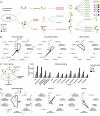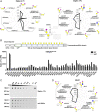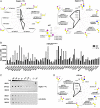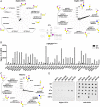Probing the binding specificities of human Siglecs by cell-based glycan arrays
- PMID: 33893239
- PMCID: PMC8092401
- DOI: 10.1073/pnas.2026102118
Probing the binding specificities of human Siglecs by cell-based glycan arrays
Abstract
Siglecs are a family of sialic acid-binding receptors expressed by cells of the immune system and a few other cell types capable of modulating immune cell functions upon recognition of sialoglycan ligands. While human Siglecs primarily bind to sialic acid residues on diverse types of glycoproteins and glycolipids that constitute the sialome, their fine binding specificities for elaborated complex glycan structures and the contribution of the glycoconjugate and protein context for recognition of sialoglycans at the cell surface are not fully elucidated. Here, we generated a library of isogenic human HEK293 cells with combinatorial loss/gain of individual sialyltransferase genes and the introduction of sulfotransferases for display of the human sialome and to dissect Siglec interactions in the natural context of glycoconjugates at the cell surface. We found that Siglec-4/7/15 all have distinct binding preferences for sialylated GalNAc-type O-glycans but exhibit selectivity for patterns of O-glycans as presented on distinct protein sequences. We discovered that the sulfotransferase CHST1 drives sialoglycan binding of Siglec-3/8/7/15 and that sulfation can impact the preferences for binding to O-glycan patterns. In particular, the branched Neu5Acα2-3(6-O-sulfo)Galβ1-4GlcNAc (6'-Su-SLacNAc) epitope was discovered as the binding epitope for Siglec-3 (CD33) implicated in late-onset Alzheimer's disease. The cell-based display of the human sialome provides a versatile discovery platform that enables dissection of the genetic and biosynthetic basis for the Siglec glycan interactome and other sialic acid-binding proteins.
Keywords: CD33; Siglecs; cell-based glycan array; sialome; sialyltransferase.
Conflict of interest statement
Competing interest statement: University of Copenhagen has filed a patent application on the cell-based display platform. GlycoDisplay ApS, Copenhagen, Denmark, has obtained a license to the field of the patent application. Y.N. and H.C. are cofounders of GlycoDisplay ApS and hold ownerships in the company.
Figures





Similar articles
-
Carbohydrate Sulfation As a Mechanism for Fine-Tuning Siglec Ligands.ACS Chem Biol. 2021 Nov 19;16(11):2673-2689. doi: 10.1021/acschembio.1c00501. Epub 2021 Oct 18. ACS Chem Biol. 2021. PMID: 34661385
-
Understanding the Glycosylation Pathways Involved in the Biosynthesis of the Sulfated Glycan Ligands for Siglecs.ACS Chem Biol. 2025 Feb 21;20(2):386-400. doi: 10.1021/acschembio.4c00677. Epub 2025 Jan 21. ACS Chem Biol. 2025. PMID: 39836965
-
A versatile soluble siglec scaffold for sensitive and quantitative detection of glycan ligands.Nat Commun. 2020 Oct 9;11(1):5091. doi: 10.1038/s41467-020-18907-6. Nat Commun. 2020. PMID: 33037195 Free PMC article.
-
Carbohydrate sulfation as a critical modulator of siglec-sialoglycan interactions.Carbohydr Res. 2025 Jul;553:109502. doi: 10.1016/j.carres.2025.109502. Epub 2025 Apr 25. Carbohydr Res. 2025. PMID: 40328158 Review.
-
Putting a cap on the glycome: Dissecting human sialyltransferase functions.Carbohydr Res. 2024 Oct;544:109242. doi: 10.1016/j.carres.2024.109242. Epub 2024 Aug 13. Carbohydr Res. 2024. PMID: 39167930 Review.
Cited by
-
The avian influenza A virus receptor SA-α2,3-Gal is expressed in the porcine nasal mucosa sustaining the pig as a mixing vessel for new influenza viruses.Virus Res. 2024 Feb;340:199304. doi: 10.1016/j.virusres.2023.199304. Epub 2024 Jan 3. Virus Res. 2024. PMID: 38142890 Free PMC article.
-
Chemoenzymatic Synthesis of Sulfated N-Glycans Recognized by Siglecs and Other Glycan-Binding Proteins.JACS Au. 2024 Jul 26;4(8):2966-2978. doi: 10.1021/jacsau.4c00307. eCollection 2024 Aug 26. JACS Au. 2024. PMID: 39211606 Free PMC article.
-
Enterovirus D-68 Infection of Primary Rat Cortical Neurons: Entry, Replication, and Functional Consequences.mBio. 2023 Apr 25;14(2):e0024523. doi: 10.1128/mbio.00245-23. Epub 2023 Mar 6. mBio. 2023. PMID: 36877033 Free PMC article.
-
Development and applications of sialoglycan-recognizing probes (SGRPs) with defined specificities: exploring the dynamic mammalian sialoglycome.Glycobiology. 2022 Nov 22;32(12):1116-1136. doi: 10.1093/glycob/cwac050. Glycobiology. 2022. PMID: 35926090 Free PMC article.
-
Siglec Signaling in the Tumor Microenvironment.Front Immunol. 2021 Dec 13;12:790317. doi: 10.3389/fimmu.2021.790317. eCollection 2021. Front Immunol. 2021. PMID: 34966391 Free PMC article. Review.
References
-
- Varki A., Schnaar R. L., Crocker P. R., “I-Type Lectins” in Essentials of Glycobiology, Varki A., et al.., Eds. (Cold Spring Harbor, NY, 2015), pp. 453–467.
-
- Duan S., Paulson J. C., Siglecs as immune cell checkpoints in disease. Annu. Rev. Immunol. 38, 365–395 (2020). - PubMed
Publication types
MeSH terms
Substances
Grants and funding
LinkOut - more resources
Full Text Sources

